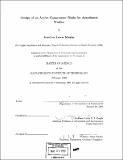Design of an active compressor blade for aeroelastic studies
Author(s)
Maahs, Gordon Lewis, 1974-
DownloadFull printable version (13.87Mb)
Advisor
Carlos E.S. Cesnik.
Terms of use
Metadata
Show full item recordAbstract
This thesis begins the development of a tool that will enable direct measurement of the unsteady aerodynamic response of a transonic compressor for use in flutter identification. The experimental apparatus, named the Active Rotor, will have active blades with individual motion control. The Active Rotor Blades, proposed in this work, uses a spar-and-shell concept which consists of a flexible outer foam shell, structural spars, and piezoelectric actuators. The graphite epoxy spars both carry the load of the blade and induce shape changes of the blade from attached piezoelectric actuators. Control of a blade shape and position to the airflow allows new experiments to be performed in the area of flutter and unsteady aerodynamics. A design study was performed to choose several of the material and geometrical properties of the Active Rotor Blade. A NASTRAN/PATRAN finite element model was developed with these design parameters to calculate the stresses in the composite spars, the level of tip rotation available from piezoelectric actuation, and the strains seen by the piezoceramic under full centrifugal loads. The spar stresses and available actuation were within required ranges, but the strain predictions on the piezoceramics were near the ultimate. The composite spar modeling and piezoelectric actuation modeling were verified with experimental results. The piezoceramics were protected from large tensile strains by bonding to the composite with a compressive prestrain. Experiments on the bond layer characterized its strength and ability to hold the desired precompression. Testing identified piezoelectric actuation under loads specific to the Active Rotor Blade: compression, release of compression, and tension. The piezoceramics were bonded to different composite layups with different Poisson's ratios to assess the effect of biaxial stress states. Results indicate that the biaxial stresses have a larger influence on actuation than the precompression. The piezoceramic was not observed to lose structural integrity or show a large loss in actuation when pulled significantly beyond its failure strain. The increased strength is attributed to the packaging designed for the Active Rotor.
Description
Thesis (S.M.)--Massachusetts Institute of Technology, Dept. of Aeronautics and Astronautics, 1999. Includes bibliographical references (p. 137-140).
Date issued
1999Department
Massachusetts Institute of Technology. Department of Aeronautics and AstronauticsPublisher
Massachusetts Institute of Technology
Keywords
Aeronautics and Astronautics